Remote Sensing Techniques for Urban Heating Analysis: A Case Study of Sustainable Construction at District Level
Abstract
:1. Introduction
2. Study Area
3. Methods
3.1. Landsat 7 ETM+ Data and Processing
3.2. LST and Albedo Retrieval from Landsat 7 Data
3.3. SUHI Computation and LST Model
4. Results and Discussion
Albedo Maps and Analytical Analysis
5. Conclusions
Acknowledgments
Author Contributions
Conflicts of Interest
References
- Oke, T.R. The energetic basis of the urban heat island. Q. J. R. Meteorol. Soc. 1982, 108, 1–24. [Google Scholar] [CrossRef]
- Voogt, J.A. Urban Heat Island: Hotter Cities. ActionBioscience.org 2004. Available online: http://www.actionbioscience.org/environment/voogt.html (accessed on 5 October 2016).
- Ogashawara, I.; Bastos, V.S.B. A Quantitative Approach for Analyzing the Relationship between Urban Heat Islands and Land Cover. Remote Sens. 2008, 4, 3596–3618. [Google Scholar] [CrossRef]
- Rizwan, A.M.; Dennis, L.Y.C.; Chunho, L.I.U. A review on the generation, determination and mitigation of Urban Heat Island. J. Environ. Sci. 2008, 20, 120–128. [Google Scholar] [CrossRef]
- Pichierri, M.; Bonafoni, S.; Biondi, R. Satellite air temperature estimation for monitoring the canopy layer heat island of Milan. Remote Sens. Environ. 2012, 127, 130–138. [Google Scholar] [CrossRef]
- Icaza, L.E.; Van Den Dobbelsteen, A.; Van Der Hoeven, F. Integrating urban heat assessment in urban plans. Sustainability 2016, 8, 320. [Google Scholar] [CrossRef]
- Mackey, C.W.; Lee, X.; Smith, R.B. Remotely sensing the cooling effects of city scale efforts to reduce urban heat island. Build. Environ. 2012, 49, 348–358. [Google Scholar] [CrossRef]
- Smith, C.; Levermore, G. Designing urban spaces and buildings to improve sustainability and quality of life in a warmer world. Energy Policy 2008, 36, 4558–4562. [Google Scholar] [CrossRef]
- Shi, Z.; Zhang, X. Analyzing the effect of the longwave emissivity and solar reflectance of building envelopes on energy-saving in various climates. Sol. Energy 2011, 85, 28–37. [Google Scholar] [CrossRef]
- Bretz, S.; Akbari, H.; Rosenfeld, A. Practical issues for using solar-reflective materials to mitigate urban heat islands. Atmos. Environ. 1998, 32, 95–101. [Google Scholar] [CrossRef]
- Taha, H.; Akbari, H.; Rosenfeld, A.; Huang, J. Residential cooling loads and the urban heat island: The effects of albedo. Build. Environ. 1988, 23, 271–283. [Google Scholar] [CrossRef]
- Suehrcke, H.; Peterson, E.L.; Selby, N. Effect of roof solar reflectance on the building heat gain in a hot climate. Energy Build. 2008, 40, 2224–2235. [Google Scholar] [CrossRef]
- Alavipanah, S.; Wegmann, M.; Qureshi, S.; Weng, Q.; Koellner, T. The role of vegetation in mitigating urban land surface temperatures: A case study of Munich, Germany during the warm season. Sustainability 2015, 7, 4689–4706. [Google Scholar] [CrossRef]
- Givoni, B. Impact of planted areas on urban environmental quality: A review. Atmos. Environ. 1991, 25, 289–299. [Google Scholar] [CrossRef]
- Gusso, A.; Cafruni, C.; Bordin, F.; Veronez, M.R.; Lenz, L.; Crija, S. Multi-temporal patterns of urban heat Island as response to economic growth management. Sustainability 2015, 7, 3129–3145. [Google Scholar] [CrossRef]
- Lee, H.Y. An application of NOAA AVHRR thermal data to the study of urban heat islands. Atmos. Environ. 1993, 27, 1–13. [Google Scholar] [CrossRef]
- Gallo, K.P.; McNab, A.L.; Karl, J T.R.; Brown, F.; Hood, J.J.; Tarpley, J.D. The use of NOAA AVHRR data for assessment of the urban heat island effect. J. Appl. Meteorol. 1993, 32, 899–908. [Google Scholar] [CrossRef]
- Streutker, D.R. Satellite-measured growth of the urban heat island of Houston, Texas. Remote Sens. Environ. 2003, 85, 282–289. [Google Scholar] [CrossRef]
- Pu, R.; Gong, P.; Michishita, R.; Sasagawa, T. Assessment of multi-resolution and multi-sensor data for urban surface temperature retrieval. Remote Sens. Environ. 2006, 104, 211–225. [Google Scholar] [CrossRef]
- Anniballe, R.; Bonafoni, S.; Pichierri, M. Spatial and temporal trends of the surface and air heat island over Milan using Modis data. Remote Sens. Environ. 2014, 150, 163–171. [Google Scholar] [CrossRef]
- Lu, D.; Weng, Q. Spectral mixture analysis of ASTER images for examining the relationship between urban thermal features and biophysical descriptors in Indianapolis, Indiana, USA. Remote Sens. Environ. 2006, 104, 157–167. [Google Scholar] [CrossRef]
- Hartz, D.A.; Prashad, L.; Hedquist, B.C.; Golden, J.; Brazel, A.J. Linking satellite images and hand-held infrared thermography to observed neighbourhood climate conditions. Remote Sens. Environ. 2006, 104, 190–200. [Google Scholar] [CrossRef]
- Weng, Q.; Hu, X.; Quattrochi, D.A.; Liu, H. Assessing Intra-Urban Surface Energy Fluxes Using Remotely Sensed ASTER Imagery and Routine Meteorological Data: A Case Study in Indianapolis, U.S.A. IEEE J. Sel. Top. Appl. Earth Obs. Remote Sens. 2014, 7, 4046–4057. [Google Scholar] [CrossRef]
- Xian, G.; Crane, M. An analysis of urban thermal characteristics and associated land cover in Tampa Bay and Las Vegas using Landsat satellite data. Remote Sens. Environ. 2006, 104, 147–156. [Google Scholar] [CrossRef]
- Yuan, F.; Bauer, M.E. Comparison of impervious surface area and normalized difference vegetation index as indicators of surface urban heat island effects in Landsat imagery. Remote Sens. Environ. 2007, 106, 375–386. [Google Scholar] [CrossRef]
- Xu, H.; Ding, F.; Wen, X. Urban Expansion and Heat Island Dynamics in the Quanzhou Region, China. IEEE J. Sel. Top. Appl. Earth Obs. Remote Sens. 2009, 2, 74–79. [Google Scholar] [CrossRef]
- Urbanpromo. Available online: urbanpromo.it/2014-en/progetti/the-project-financing-of-corso-del-popolo-in-terni/ (accessed on 15 November 2016).
- Regione Umbria—Giunta Regionale—SIAT Sistema Informativo Regionale Ambientale e Territoriale. Available online: siat.regione.umbria.it/paesaggineltempo/ (accessed on 1 December 2016).
- U.S. Geological Survey, Earth Explorer. Available online: earthexplorer.usgs.gov (accessed on 15 December 2016).
- Chander, G.; Markham, B.L.; Helder, D.L. Summary of Current Radiometric Calibration Coefficients for Landsat MSS, TM, ETM+, and EO-1 ALI sensors. Remote Sens. Environ. 2009, 113, 893–903. [Google Scholar] [CrossRef]
- Chavez, P.S. Image-based atmospheric corrections—Revisited and improved. Photogramm. Eng. Remote Sens. 1996, 62, 1025–1036. [Google Scholar]
- Jimenez-Munoz, J.C.; Sobrino, J.A. A generalized single-channel method for retrieving land surface temperature from remote sensing data. J. Geophys. Res. 2003, 108, 1–9. [Google Scholar] [CrossRef]
- Bonafoni, S. Downscaling of Landsat and MODIS Land Surface Temperature over the heterogeneous urban area of Milan. IEEE J. Sel. Top. Appl. Earth Obs. Remote Sens. 2016, 9. [Google Scholar] [CrossRef]
- Atmospheric Correction Parameter Calculator. Available online: https://atmcorr.gsfc.nasa.gov/ (accessed on 10 January 2017).
- Barsi, J.A.; Barker, J.L.; Schott, J.R. An atmospheric correction parameter calculator for a single thermal band earth-sensing instrument. In Proceedings of the IEEE International Geoscience and Remote Sensing Symposium, Toulouse, France, 21–25 July 2003; pp. 3014–3016. [Google Scholar]
- Sobrino, J.A.; Jimenez-Munoz, J.C.; Paolini, L. Land surface temperature retrieval from LANDSAT TM 5. Remote Sens. Environ. 2004, 90, 434–440. [Google Scholar] [CrossRef]
- Bonafoni, S. The spectral index utility for summer urban heating analysis. J. Appl. Remote Sens. 2015, 9. [Google Scholar] [CrossRef]
- Liang, S. Narrowband to broadband conversions of land surface albedo—I Algorithms. Remote Sens. Environ. 2001, 76, 213–238. [Google Scholar] [CrossRef]
- Schaepman-Strub, G.; Schaepman, M.E.; Painter, T.H.; Dangel, S.; Martonchik, J.V. Reflectance quantities in optical remote sensing-definitions and case studies. Remote Sens. Environ. 2006, 103, 27–42. [Google Scholar] [CrossRef]
- Baldinelli, G.; Bonafoni, S.; Anniballe, R.; Presciutti, A.; Gioli, B.; Magliulo, V. Spaceborne detection of roof and impervious surface albedo: Potentialities and comparison with airborne thermography measurements. Sol. Energy 2015, 113, 281–294. [Google Scholar] [CrossRef]
- Park, J.-H.; Cho, G.-H. Examining the Association between Physical Characteristics of Green Space and Land Surface Temperature: A Case Study of Ulsan, Korea. Sustainability 2016, 8, 777. [Google Scholar] [CrossRef]
- Yang, X.; Chen, Z.; Cai, H.; Ma, L. A Framework for Assessment of the Influence of China’s Urban Underground Space Developments on the Urban Microclimate. Sustainability 2014, 6, 8536–8566. [Google Scholar] [CrossRef]
- Loughner, C.P.; Allen, D.J.; Zhang, D.; Pickering, K.E.; Dickerson, R.R.; Landry, L. Roles of Urban Tree Canopy and Buildings in Urban Heat Island Effects: Parameterization and Preliminary Results. J. Appl. Meteorol. Climatol. 2012, 51, 1775–1793. [Google Scholar] [CrossRef]
- Hu, W.; Liao, X. Practice on improvement of urban thermal environment with evaporation combined CFD simulation. In Modeling and Computation in Engineering II; Liquan, X., Ed.; Taylor and Francis Group: London, UK, 2013. [Google Scholar]
- Bonafoni, S.; Baldinelli, G.; Verducci, P. Sustainable strategies for smart cities: Analysis of the town development effect on surface urban heat island through remote sensing methodologies. Sustain. Cities Soc. 2017, 29, 211–218. [Google Scholar] [CrossRef]
- Rossi, F.; Castellani, B.; Presciutti, A.; Morini, E.; Anderini, E.; Filipponi, M.; Nicolini, A. Experimental evaluation of urban heat island mitigation potential of retro-reflective pavement in urban canyons. Energy Build. 2016, 126, 340–352. [Google Scholar] [CrossRef]
- Kotthaus, S.; Thomas Smith, E.L.; Wooster, M.J.; Grimmond, C.S.B. Derivation of an urban materials spectral library through emittance and reflectance spectroscopy. SPRS J. Photogramm. Remote Sens. 2014, 94, 194–212. [Google Scholar]
- Weather Underground 2017. Available online: http://www.wunderground.com (accessed on 15 February 2017).
- Echevarría Icaza, L.; van den Dobbelsteen, A.; van der Hoeven, F. Integrating Urban Heat Assessment in Urban Plans. Sustainability 2016, 8, 320. [Google Scholar] [CrossRef]

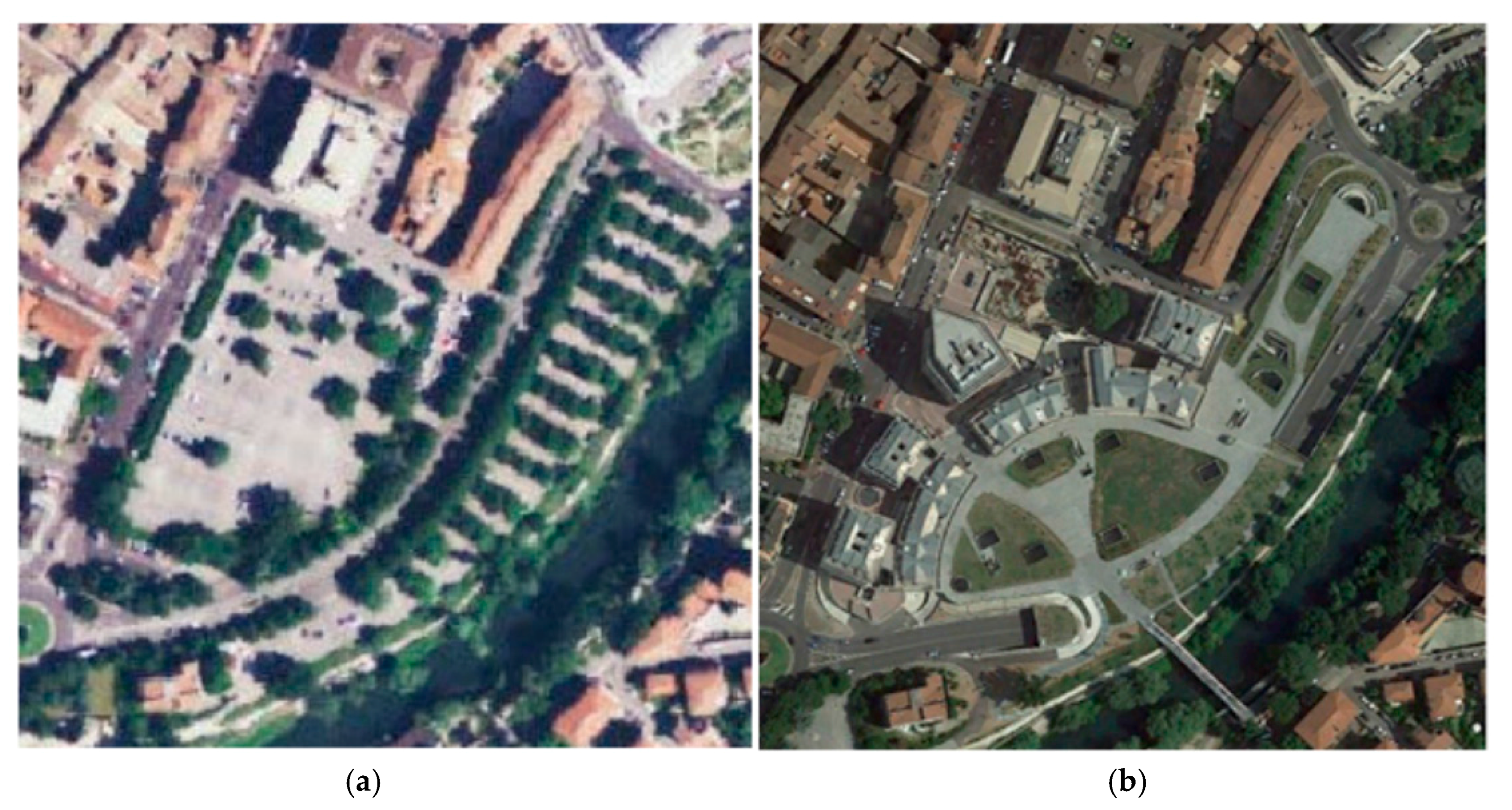
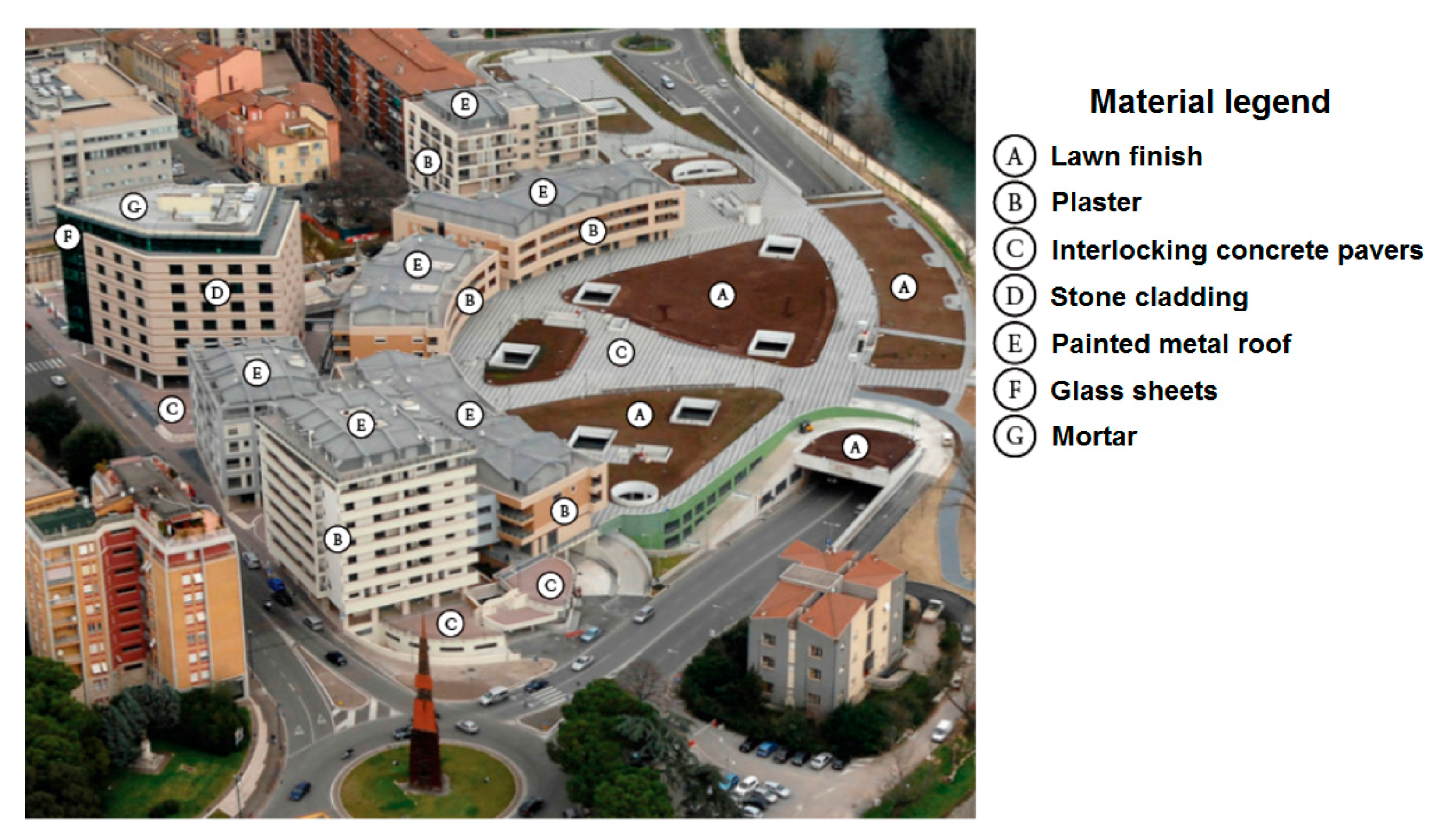
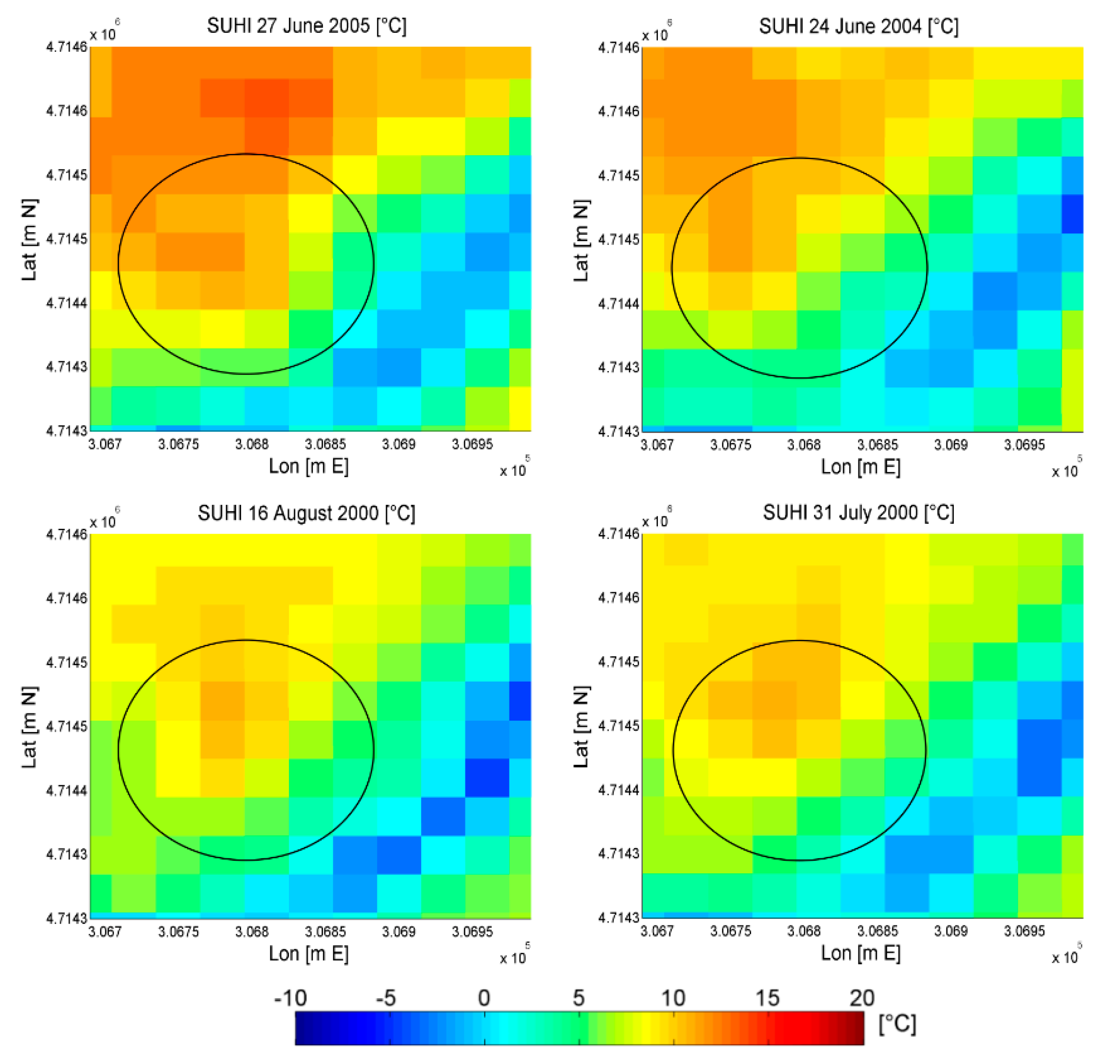
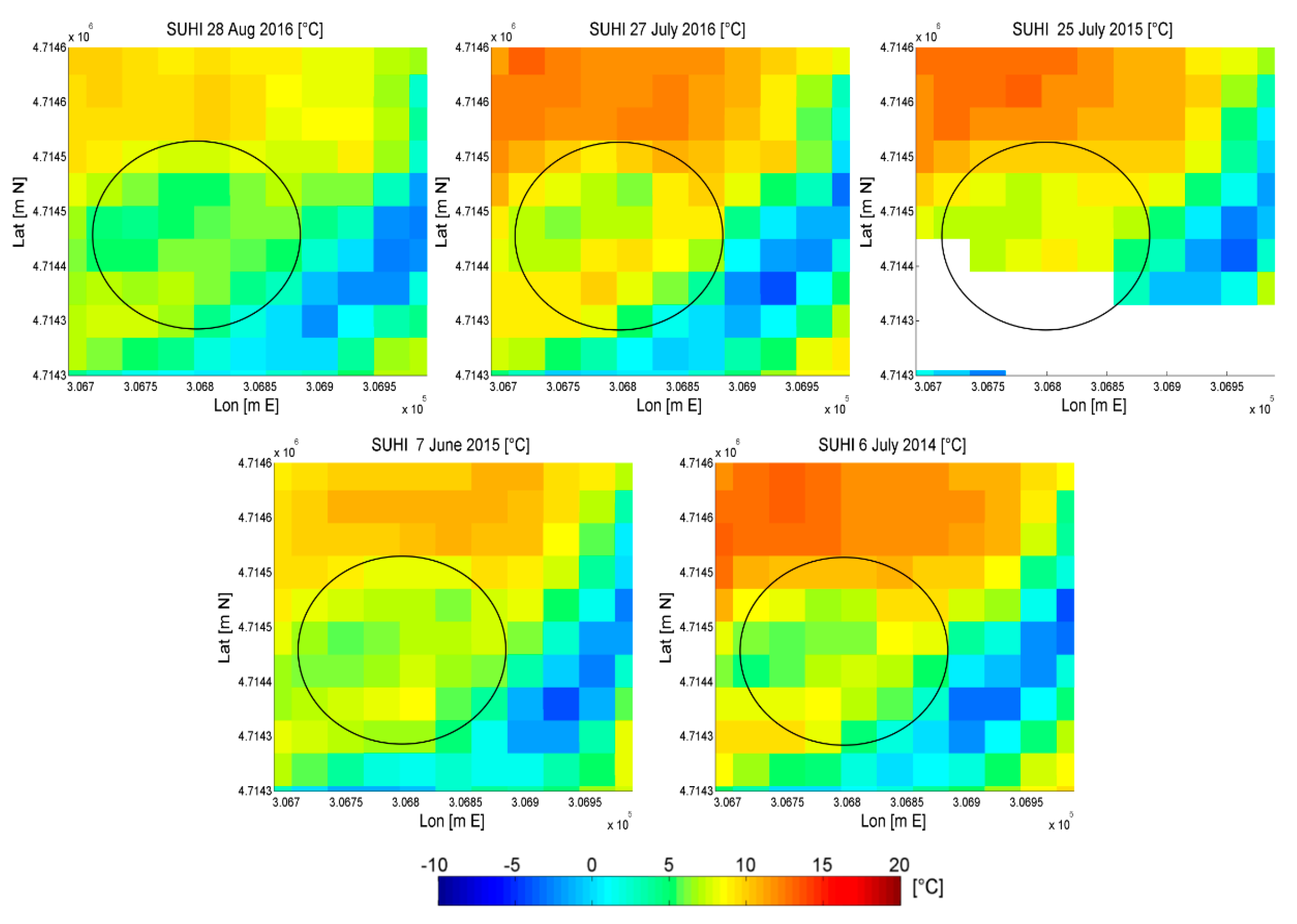
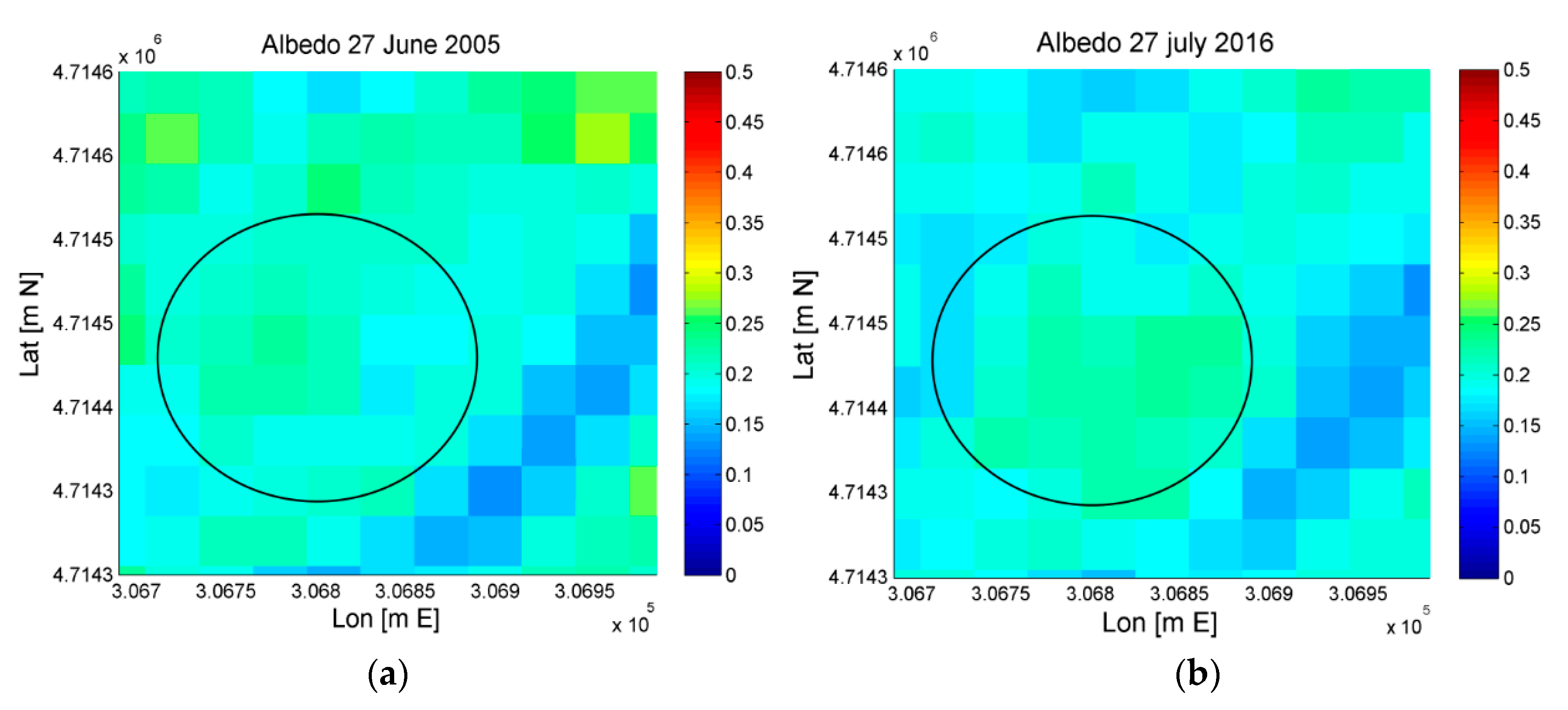
| ETM + Channels | Spectral Range (µm) |
|---|---|
| Ch_1—VIS (blue) | 0.45–0.51 |
| Ch_2—VIS (green) | 0.52–0.60 |
| Ch_3—VIS (red) | 0.63–0.69 |
| Ch_4—NIR | 0.77–0.90 |
| Ch_5—SWIR | 1.55–1.75 |
| Ch_6—TIR | 10.31–12.36 |
| Ch_7—SWIR | 2.06–2.35 |
| Ch_8—panchromatic | 0.52–0.90 |
| Period | Date |
|---|---|
| Pre-Intervention | 27 June 2005, 24 June 2004, 16 August 2000, 31 July 2000 |
| Post-Intervention | 28 August 2016, 27 July 2016, 25 July 2015, 7 June 2015, 6 July 2014 |
| Varying Parameter | Fixed Parameters | LST Variation (°C) | LST Variation (%) |
|---|---|---|---|
| α: 0.13 ÷ 0.40 | ε = 0.93 Tsky = 283 K Ta = 30°C hc = 15 W/m2·K | 60.9 ÷ 50.2 | −17% |
| ε: 0.85 ÷ 0.95 | α = 0.25 Tsky = 283 K Ta = 30°C hc = 15 W/m2·K | 57.3 ÷ 55.9 | −2% |
| Tsky: 278 ÷ 288 K | α = 0.25 ε = 0.93 Ta = 30°C hc = 15 W/m2·K | 55.2 ÷ 57.3 | +3% |
| Ta: 25 ÷ 35 °C | α = 0.25 ε = 0.93 Tsky = 283 K hc = 15 W/m2·K | 52.8 ÷ 59.5 | +13% |
| hc: 10 ÷ 20 W/m2·K | α = 0.25 ε = 0.93 Tsky = 283 K Ta = 30 °C | 66.3 ÷ 55.1 | −17% |
© 2017 by the authors. Licensee MDPI, Basel, Switzerland. This article is an open access article distributed under the terms and conditions of the Creative Commons Attribution (CC BY) license (http://creativecommons.org/licenses/by/4.0/).
Share and Cite
Bonafoni, S.; Baldinelli, G.; Verducci, P.; Presciutti, A. Remote Sensing Techniques for Urban Heating Analysis: A Case Study of Sustainable Construction at District Level. Sustainability 2017, 9, 1308. https://doi.org/10.3390/su9081308
Bonafoni S, Baldinelli G, Verducci P, Presciutti A. Remote Sensing Techniques for Urban Heating Analysis: A Case Study of Sustainable Construction at District Level. Sustainability. 2017; 9(8):1308. https://doi.org/10.3390/su9081308
Chicago/Turabian StyleBonafoni, Stefania, Giorgio Baldinelli, Paolo Verducci, and Andrea Presciutti. 2017. "Remote Sensing Techniques for Urban Heating Analysis: A Case Study of Sustainable Construction at District Level" Sustainability 9, no. 8: 1308. https://doi.org/10.3390/su9081308





